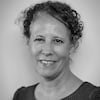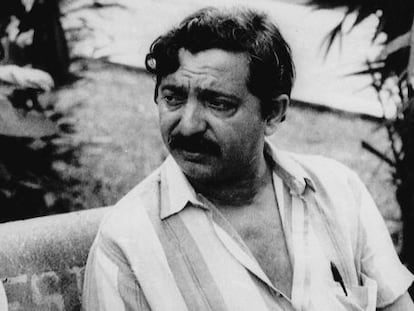Brazil issues solemn apology to Indigenous people for the atrocities committed during the dictatorship
The unprecedented step coincides with the 60th anniversary of the coup d’état that gave rise to a military regime responsible for the deaths of over 8,300 natives


Numerous atrocities were committed by Brazilian state officials against Indigenous people during the dictatorship (1964-1985). Some of these were quite shocking and perverse, such as the administration of sugar mixed with strychnine, a rat poison. This week, coinciding with the 60th anniversary of the coup that marked the beginning of two decades of military rule, the Brazilian state issued a solemn apology for evicting them from their land, locking them up in internment camps and torturing them. The official ceremony concluded in a scene of tremendous symbolism: “I want to kneel before you. I am deeply moved. I want to apologize on behalf of Brazil. And to convey this request for apology to all your people,” said lawyer Enéa de Stutz e Almeida on behalf of the government to matriarch Djanira Krenak and Guarani-Kaiowá chief Tito Vilhalva at a ceremony held in Brasília last Tuesday.
The gesture was specifically directed at two of Brazil’s 266 Indigenous populations, the Guarani-Kaiowá and the Krenak, because years ago they went to the Amnesty Commission, a government agency chaired by Stutz, to ask for a collective apology.

“The whole process developed over the years was highly relevant and extremely important,” explains 40-year-old Shirley Krenak in a message exchange. The Indigenous people generally take the name of their people as their surname. For the natives, it was crucial for the apology to be in accordance with their uses and customs and, therefore, to be collective, not individual. “It is an important moment because we are opening a big door to [similar] actions of other Indigenous peoples,” she adds. This represents a first step that paves the way for claims by other peoples or for a hypothetical admission of responsibility for the persecution endured by the Indigenous peoples.
Brazil is immersed in the excruciating process of admitting its guilt in the darkest chapters of its collective history. Recently, the Bank of Brazil issued an apology for its complicity in slavery.
More than 8,300 Indigenous people were killed through state action or neglect during the dictatorship, according to the final report of the National Truth Commission, published in 2014. The commission dedicated a chapter to the violations of the human rights of the Indigenous populations, but, remarkably, this body did not include them in the official count of the dead and disappeared, which contains 434 names associated with political reprisals (and those of 377 repressors). The apology has shone a spotlight on the brutal persecution of Indigenous people during the dictatorship, a scarcely publicized part of the years of repression.
The atrocities had been documented since the late 1960s by a team of officials under the leadership of prosecutor Jader de Figueiredo. After traveling nearly 10,000 miles, he produced a detailed report that pointed the finger at the Indian Protection Service, an agency that, far from protecting the Indigenous people, instead attempted to exterminate them in order to favor large landowning farmers.
For decades, it was believed that Figueiredo’s report had been destroyed in a fire. But this was not the case. The persistence of a researcher, Marcelo Zelic, proved decisive for Brazilians learning the chilling details of the treatment handed out by the generals’ regime to the country’s first inhabitants. Zelic succeeded in finding the archive in 2013 at the Indian Museum, in Rio de Janeiro.
Its content makes for frightening reading. “The Cinta Larga group, in Mato Grosso, were reportedly exterminated with dynamite dropped from airplanes and strychnine with sugar, while the Mateiros [farmers’ patrol guard] hunted them down with machine gun fire, and slashed them alive with machetes from head to pubic bone.” These are some of the atrocities described in the 5,000-page report. Zelic also denounced impunity and said that he had met one of the perpetrators of “hideous crimes,” who calmly sold ice cream to some kids in Cuiabá, “without being disturbed by the justice system.”
For the military, colonizing the Amazon and the inland areas of Brazil, inhabited by Indigenous people for millennia, was an essential part of their crusade to ensure that no foreign power would steal the world’s largest tropical rainforest with all its riches, in defense of civilization and against communism. In 1969, the military regime established a camp known as the Krenak reformatory in Resplendor (Minas Gerais). This was a reeducation camp for Indigenous people believed to be rebels or subversives who were subjected to forced labor and cultural assimilation.
In 1969, the generals also recruited around 90 Indigenous people who knew some Portuguese to become soldiers and subdue their own people. Two uniformed members of the Indigenous Rural Guard were involved in one of the most infamous scenes of that period, recovered in the short film entitled Arara: um filme sobre um filme sobrevivente (which translates to “Macawa: A film about a surviving film”). The original black and white film with yellowish tones was retrieved from oblivion by a researcher. It shows a military parade that in 1970 reunited the highest political and military authorities and hundreds of citizens in an avenue of Belo Horizonte, the fourth-largest Brazilian city. Among the hundreds of soldiers at the parade, two uniformed Indians carry a third Indian hanging from a pole, bound by his hands and feet. What in Brazil is called pau de arara (macaw stick) was one of the forms of torture employed during the dictatorship.
The Krenak people, from the state of Minas Gerais, and the Guarani-Kaiowá, from Mato Grosso, presented their request for a collective apology many years ago. However, it was only in 2023, coinciding with the creation of the Ministry of Native People and the reinforcement of Indigenous organizations by Luiz Inácio Lula da Silva’s government, that the issue finally emerged from its lethargy. The natives insist that the most important measure to protect them and the biodiversity of their lands is the demarcation of Indigenous lands, and they demand that Lula speed up efforts in this direction.
Krenak, the activist, reveals that once the state has issued an apology, the next steps are to demand financial reparations and a museum to recount the story so that both schoolchildren and institutions can learn about it.
Brazil’s Indigenous population — almost 1.7 million people, less than 1% of the population — have acquired enormous political, cultural and social importance over the years. This Saturday, for the first time, one of them, the philosopher and writer Ailton Krenak, was admitted to the Brazilian Academy of Letters.

From the rostrum of the Brazilian Congress, Ailton Krenak reminded his compatriots that “the Indigenous peoples’ blood has been spilled on every one of Brazil’s eight million square kilometers” as he painted his face with black pigment in protest, which contrasted powerfully with his pristine white suit.
Sign up for our weekly newsletter to get more English-language news coverage from EL PAÍS USA Edition
Tu suscripción se está usando en otro dispositivo
¿Quieres añadir otro usuario a tu suscripción?
Si continúas leyendo en este dispositivo, no se podrá leer en el otro.
FlechaTu suscripción se está usando en otro dispositivo y solo puedes acceder a EL PAÍS desde un dispositivo a la vez.
Si quieres compartir tu cuenta, cambia tu suscripción a la modalidad Premium, así podrás añadir otro usuario. Cada uno accederá con su propia cuenta de email, lo que os permitirá personalizar vuestra experiencia en EL PAÍS.
¿Tienes una suscripción de empresa? Accede aquí para contratar más cuentas.
En el caso de no saber quién está usando tu cuenta, te recomendamos cambiar tu contraseña aquí.
Si decides continuar compartiendo tu cuenta, este mensaje se mostrará en tu dispositivo y en el de la otra persona que está usando tu cuenta de forma indefinida, afectando a tu experiencia de lectura. Puedes consultar aquí los términos y condiciones de la suscripción digital.
More information
Archived In
Últimas noticias
Most viewed
- Reinhard Genzel, Nobel laureate in physics: ‘One-minute videos will never give you the truth’
- Oona Chaplin: ‘I told James Cameron that I was living in a treehouse and starting a permaculture project with a friend’
- Pablo Escobar’s hippos: A serious environmental problem, 40 years on
- Why we lost the habit of sleeping in two segments and how that changed our sense of time
- Charles Dubouloz, mountaineering star, retires at 36 with a farewell tour inspired by Walter Bonatti










































